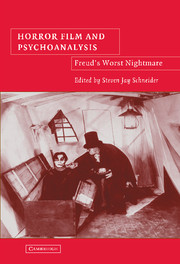Book contents
- Frontmatter
- Contents
- Acknowledgments
- Foreword: “What Lies Beneath?”
- Introduction: “Psychoanalysis in/and/of the Horror Film”
- PART ONE THE QUESTION OF HORROR-PLEASURE
- 1 “What's the Matter with Melanie?”: Reflections on the Merits of Psychoanalytic Approaches to Modern Horror Cinema
- 2 A Fun Night Out: Horror and Other Pleasures of the Cinema
- 3 Excerpt from “Why Horror? The Peculiar Pleasures of a Popular Genre,” with a New Afterword by the Author
- 4 Philosophical Problems Concerning the Concept of Pleasure in Psychoanalytical Theories of (the Horror) Film
- PART TWO THEORIZING THE UNCANNY
- PART THREE REPRESENTING PSYCHOANALYSIS
- PART FOUR NEW DIRECTIONS
- Afterword: Psychoanalysis and the Horror Film
- About the Contributors
- Bibliography
- Index
1 - “What's the Matter with Melanie?”: Reflections on the Merits of Psychoanalytic Approaches to Modern Horror Cinema
Published online by Cambridge University Press: 14 July 2009
- Frontmatter
- Contents
- Acknowledgments
- Foreword: “What Lies Beneath?”
- Introduction: “Psychoanalysis in/and/of the Horror Film”
- PART ONE THE QUESTION OF HORROR-PLEASURE
- 1 “What's the Matter with Melanie?”: Reflections on the Merits of Psychoanalytic Approaches to Modern Horror Cinema
- 2 A Fun Night Out: Horror and Other Pleasures of the Cinema
- 3 Excerpt from “Why Horror? The Peculiar Pleasures of a Popular Genre,” with a New Afterword by the Author
- 4 Philosophical Problems Concerning the Concept of Pleasure in Psychoanalytical Theories of (the Horror) Film
- PART TWO THEORIZING THE UNCANNY
- PART THREE REPRESENTING PSYCHOANALYSIS
- PART FOUR NEW DIRECTIONS
- Afterword: Psychoanalysis and the Horror Film
- About the Contributors
- Bibliography
- Index
Summary
The past decade has been hard on psychoanalysis. When Time magazine commissions a leading contemporary psychoanalytic scholar, historian Paul Gray, to write a cover story on “The Assault on Freud” (November 29, 1993), it is clear that the bashing has become so predominant and widespread to have entered, in fact, the mainstream. The attacks have come from many fronts, indeed from all angles – new critics joining forces with older, more famous opponents. The few staunch (or shall we say obtuse?) defenders circle the wagons and hope, at most, to be able to sustain the assault a little longer…. Perhaps, though, the gravest danger doesn't come from these critics, who are, after all, still mere thinkers. How can practitioners and scholars of psychoanalysis worry about theoretical challenges when the dire twins of psychopharmacology and HMOs appear so steadfastly intent on starving Freud's creature to death? Forget the academic debates! Today what is truly doing psychoanalysis in is capitalism's good old-fashioned market logic.
In these unusually difficult times for psychoanalysis, it is not surprising that its influence within film theory has been fading as well. The first (and perhaps the last) nail in the coffin was the 1996 publication of David Bordwell and Noël Carroll's massive anthology, Post-Theory: Reconstructing Film Studies.
- Type
- Chapter
- Information
- Horror Film and PsychoanalysisFreud's Worst Nightmare, pp. 17 - 34Publisher: Cambridge University PressPrint publication year: 2004

